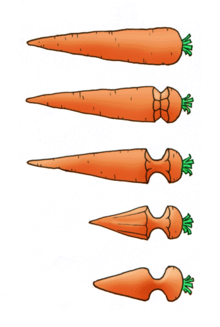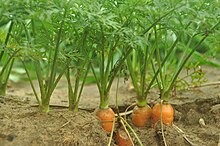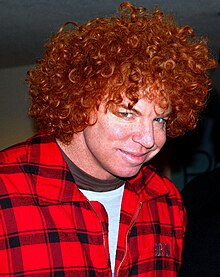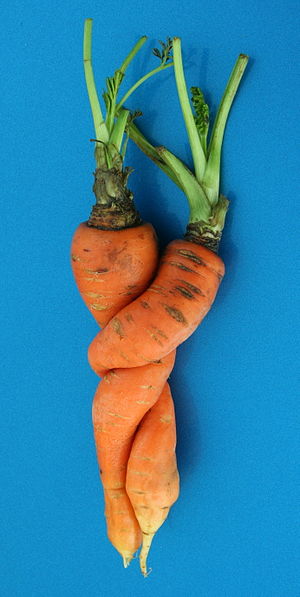Wikipedia:Wikipedia Signpost/2018-12-01/Humour
Dangerous carrots
A major carrot-teristic of our favorite orange vegetable (sorry pumpkins) is their affectionate nature. Don't be fooled. Just like the smiling family pit bull, they will eventually turn on you. While this underground root can be oddly shaped, others are heralded for their amusing appearance for obvious reasons. Carrots can kill.[1]
Causes






Not all experience the dark side of this root vegetable. Indeed, carrots have aggressively begun a successful effort to change their image. See this website to see how their public relations team has revamped their image. Carrots have also developed their own version of AI – and they have targeted humans and our tendency to expand our waistlines.[2] Carrots are well adapted in handling stress. When their taproot is growing and the tip is damaged, it can split, forming multiple roots at odd angles. During its primordium (plant embryonic development) stage, damage to the growing vegetable can cause more bizarre and extreme mutations.[3]
Carrots will naturally grow around or avoid obstacles in the soil such as small stones and other foreign objects to prevent damage to the developing root, resulting in a wide variety of different shapes.[4]
Other vegetables and fruits have been made to suffer. In Japan, farmers around Zentsūji, Kagawa found a way to grow cubic watermelons by growing the fruits in glass boxes and letting them naturally assume the shape of the receptacle. The square-shaped watermelon was intended to make the melons easier to stack and store, but because the melons must be picked before they’re ripe they are inedible; the cubic watermelons are also often more than double the price of normal watermelons.[5]
Legislation
In response to the real carrot danger, the European Union attempted to introduce legislation prohibiting the sale of misshapen fruit and vegetables was defeated. The proposed "uniform standardisation parameters" would have applied to straight bananas and curved cucumbers, as well as to more extreme cases such as carrots with multiple "legs", or fused fruit. The main concern for opponents of the proposed legislation was the ethical question of the wastage it would have generated if growers were forced to discard up to 20% of their crop, produce that was nutritionally identical to more regularly shaped specimens.[6] The Fruits et légumes moches (ugly fruit and vegetables) campaign aims to encourage the purchase of more unusually shaped vegetables and fruits in France, to combat food waste.[7]
Competitions
It is common in some countries to celebrate the diversity of carrots, with particularly unusual items being entered into competitions. Many of these are judged by the ugliness of the vegetable.[8] Some organisations run contests in which gardeners enter the largest vegetables that they have grown, with pumpkins being particular favourites.[9]
In popular culture
The phrase, "Kau ni tahap carrot pun tak sampai!" which means "You don't even reach the level of a carrot," has recently been used as an insult.[10] The popular BBC television programme That's Life! mixed investigative journalism with more lighthearted sections, which included items on unusually shaped vegetables.[11]
The BBC comedy television programme Blackadder contains several jokes relating to the character Baldrick and his obsession with odd-shaped turnips. The most notable example occurs in the episode "Beer", in which Baldrick discovers a turnip shaped like a phallus, giving rise to several jokes throughout the episode.
Ben Elton's novel This Other Eden is set in a future in which most aspects of life are controlled to conformity, meaning the loss of 'amusingly shaped vegetables', much to the protagonist's annoyance.
A giant vegetable competition featured in Wallace & Gromit: The Curse of the Were-Rabbit.
Gallery
-
Say hi to junior.
-
It is time to hop into your carrot pants.
-
Genetic variations.
-
Carrots can get moldy.
-
This carrot is impersonating an upside-down cow udder.
-
Silly Mr. Carrot.
-
When a carrot goes bad, they will end up in jail with their cricket prison guards.
-
The carrot-synchronized swim team taking a short break during practice.
References
- ^ Laurie Tarkan (May 24, 2010), "The 10 Biggest Choking Hazards", The New York Times
- ^ 7 Minutes in Hell Workout, Meet Carrot official website by Grailr, accessed November 19, 2018
- ^ Plant Answers. "Why are some of my vegetables growing into such odd and unusual shapes?". Retrieved 5 June 2007.
- ^ "Hints From Heloise: Hairy strings a carrot thing?". The Washington Post. Retrieved 29 March 2018.
- ^ BBC News. 15 June 2001. "Square fruit stuns Japanese shoppers". Retrieved 5 June 2007.
- ^ "Wonky fruit to stay on sale in EU". BBC News. 25 March 2010.
- ^ "Fruits et légumes moches: moins chers et désormais disponibles partout". L'Express (in French). 16 October 2014. Retrieved 25 March 2018.
- ^ Cornwall County Council. 16 September 2005. "Giant Vegetable Competition and Show at Kehelland Horticultural Centre[dead link]". Retrieved 22 October 2010.
- ^ Cheung, Maxine. The Toronto Observer. "Stouffville grower squashes the competition at the Royal Winter Fair". Retrieved 5 June 2007.
- ^ Khairy whacks Papagomo for being 'lower than a carrot', The Star (Malaysia), November 11, 2018
- ^ "Rantzen's years in the limelight". BBC. 16 June 2006. Retrieved 29 August 2013.
External links
- Love Carrots and Other Vegetables – "A sporadic photographic journal of weird or humorous vegetables"
- The Mutato Collection – "A collection of non-standard fruits, roots and vegetables"
- MoFa-Museum of Food Anomalies – "An online exhibition of the Art of Regular Food Gone Horribly Wrong"
- BBC News – "Attempt at EU-wide 'wonky fruit and veg' ban fails"












Discuss this story
Pretty good article but I dare say, was it by accident or design that no mention of the human complications that being a carrot top brings to our unfortunate children? How can this article be complete without a mention of one of the most famous carrot tops of all time? These unfortunate people should not be just hidden away as though their lives don't matter. They do!!! Take for example Anne "Carrots" of Green Gables. Just look what it did to her (more recent photo here) [1]. Following the latest edition of Anne's story a literary scholar gave this report:
BTW, I LOVED this article--it's one of the best, maybe the best, thing I've ever read here. Gandydancer (talk) 19:03, 1 December 2018 (UTC)[reply]
This is my first time checking out the Signpost and this is the essay I encounter....no more carrots for me.-Sıgehelmus (Tålk) 01:57, 8 December 2018 (UTC)[reply]